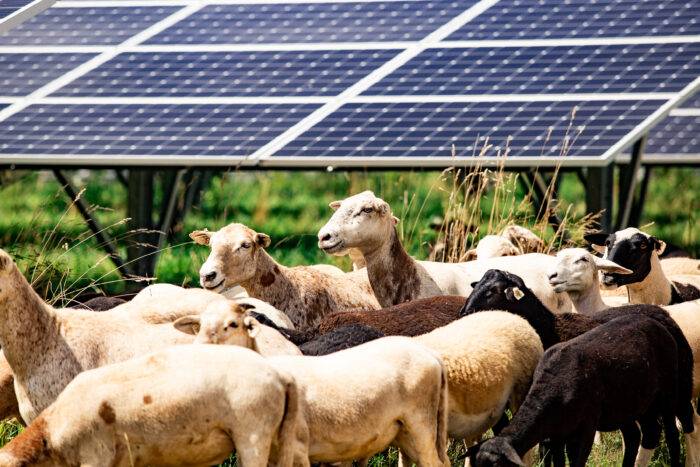

On May 31, 2023, Senators Heinrich (D-NM) and Braun (R-IN) introduced the Agrivoltaics Research and Demonstration Act of 2023 (S. 1778). Featuring a proposal first outlined in the Agriculture Resilience Act (ARA), the bill provides for the Department of Energy (DoE) and Department of Agriculture (USDA) to jointly focus on advancing research on agrivoltaics and demonstrations of the value of such systems.
Agrivoltaics systems combine solar panels (i.e., photovoltaic systems) with agricultural production. For example, such systems include grazing sheep or cattle under solar panels. Growing vegetables or pollinator-friendly plants with panels also fall into this category. By adding panels to farmland, producers reap the benefits of producing their own energy without reducing their acres in production. In fact, solar panels can improve the productivity of appropriate crops and reduce water loss. The panels themselves also benefit from sitting in thriving farmland because it can reduce their operating temperatures, making them more efficient.
Of course, one of the consequent advantages of agrivoltaics systems is that they can increase farm profit. By either reducing farm energy costs or by selling energy to the grid, farmers can gain more income while maintaining their existing farm profits.
The work on agrivoltaic systems has rapidly advanced, as reflected in the extensive research available on the National Center for Appropriate Technology’s Agrisolar Clearinghouse. However, questions remain: What is the best height of solar panels for sheep in your area? Which crops thrive under solar panels in dry, northern climates? The specifics of agrivoltaics implementation, in other words, still need to be carefully considered.
That said, we already know that agrivoltaics provide strong benefits in grazing systems and in sunny climates.
Based on these known benefits, and the need for further research into the unknowns, Senators Heinrich and Braun introduced the bill so that USDA and the DoE can collaborate to more thoroughly determine the ways in which panels should be placed and to demonstrate what successful systems look like.
The bill creates a study on agrivoltaic systems to identify existing gaps in the research. That includes questions like the best designs for panels, as well as how animal handling considerations like fencing and manure management may harmonize with panel use. It will also include examination of the potential for breed selection for agrivoltaic systems. For cropping systems, the study will also examine recommendations for panel design and impacts on crop yields, soil moisture, and associated market opportunities. The study will also more broadly look into the risks and benefits, economic scalability, and best options for agricultural land for such systems. Finally, it will assess how agrivoltaic systems can best fit into existing agricultural conservation, risk management, renewable energy, procurement, and investment tax credit programs. Based on the study, DoE and USDA will develop a regulatory definition of agrivoltaics.
In addition to research, the bill calls for the National Institutes of Food and Agriculture and DoE to establish and maintain a network of demonstration sites operated by the Agricultural Research Service. The sites are to be in multiple regions of the US, including arid, semi-arid, and wet agricultural zones. They will demonstrate the ways in which agrivoltaic systems can increase farm productivity, profitability, resilience, and biodiversity. In addition, they will demonstrate ways to increase economic opportunities in rural communities. The sites will collaborate with the Climate Hubs and extension programs as they share research and educate producers.
The bill comes with an authorization of appropriations of $ 15,000,000 for 2024 through 2028.
NSAC is excited to see this important, bipartisan policy moving f toward inclusion in the Farm Bill and applauds Senators Heinrich and Braun for their leadership on this issue. We look forward to seeing additional sections of the ARA move forward with bipartisan support along the same lines.
The post Bipartisan Agrivoltaics Bill Introduced in Senate appeared first on National Sustainable Agriculture Coalition.